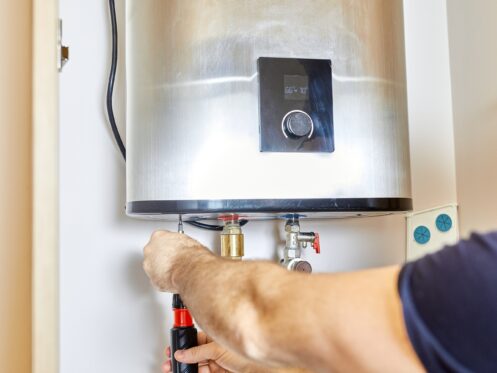Summer brings extra showers, outdoor cleanups, and guests, putting more demand on your water heater. Traditional tank water heater systems often struggle with high demand and energy waste this time of year. Learn more about how efficient, on-demand tankless systems work smarter during the hottest months.
You Don’t Need to Keep a Tank Hot When You’re Not Using It
Traditional water heaters work by keeping a tank of water hot all day. That means even when you’re not using any water, the heater kicks on to maintain the temperature inside the tank. When you’re often out of the house, that cycle keeps going anyway. Whether you’re showering twice a day or spending long weekends away, it runs.
A tankless water heater allows you to avoid all that. It heats water only when you turn on the tap. Nothing sits in storage waiting to be used. That alone makes a difference in energy usage. You’re not constantly burning fuel or electricity to maintain a set temperature. You get hot water when you ask for it, and the system shuts off when you’re done. The simplicity of that function is one of the biggest reasons more homeowners switch during the warmer months.
Hotter Weather Means Your System Works Less
When the air and incoming water are already warm, your tankless unit doesn’t have to work as hard to bring water up to your set temperature. The system detects the starting temperature and adjusts the burners accordingly. During winter, cold groundwater takes more energy to heat, but in the summer, that process moves faster and requires less power.
That puts less strain on the unit and keeps it running more efficiently. You still get hot water on demand, but the process uses less gas or electricity because the difference between the water’s starting point and your desired temperature isn’t as large.
Summer Routines Benefit From On-Demand Hot Water
Your daily schedule often changes in the summer. Whether you have more guests in the house, extra laundry from pool days, or everyone taking showers at different times, your water heater gets more action than usual. With a tank system, that means you could run out of hot water if too many people use it back to back.
With a tankless heater, you don’t have to wait. The system doesn’t run out because it heats water as it flows through. That flexibility comes in handy when your routine isn’t as predictable. If your teenager takes a long shower right before your in-laws show up, you won’t be stuck waiting for the tank to catch up. You also avoid heating water that is never used. If the dishwasher runs late at night or someone showers early in the morning, the heater fires up for that moment and turns off right after. It works with your habits instead of running on its own schedule.
You Use Less Energy Without Changing Anything Else
A lot of energy-saving changes feel like compromising, but a tankless system saves energy without requiring you to change how you use hot water. That’s a big part of why people like it, especially during warmer months when utility bills already run high from cooling costs.
You don’t have to space out loads of laundry or adjust your shower schedule. The heater gives you what you need when you need it and doesn’t heat anything until you ask. That cut in standby energy use adds up over time, especially in summer when hot water demand is spread out across the day instead of centered around morning and evening.
If you’ve already taken steps to save energy in other areas of your home, switching to tankless adds another layer without disrupting your comfort. It’s a practical way to lower your usage without sacrificing anything in return.
Knowing How to Set Your Summer Temperature Helps Performance
A lot of people leave their water heaters set too high without realizing it. That can waste energy and increase wear on the system. In summer, you usually don’t need the water to be as hot. Lowering the set point on your tankless unit to around 120 degrees Fahrenheit helps you get comfortable water without using extra fuel or electricity.
That adjustment also makes the system respond faster. With less of a gap between the inlet and outlet temperatures, the water reaches your taps more quickly. That means less water is wasted waiting for it to heat up, and the burner doesn’t have to work as hard to make up the difference.
You can usually adjust the temperature with a few button presses on the control panel. If your model doesn’t have an easy interface or you’re unsure what it’s set to, a technician can check it during a routine maintenance visit and make any needed changes.
Keeping Up With Maintenance Gives You a Better Return
Tankless water heaters don’t need much to stay in good shape, but they do benefit from routine maintenance. During summer, when demand picks up and the unit might run more often, it’s a good idea to have it checked. That includes flushing the system to remove any mineral buildup, checking the burner for debris, and making sure the venting stays clear.
Hard water can cause scale to form inside the heat exchanger. That slows down performance and makes the unit work harder to produce the same results. Flushing the system once or twice a year helps avoid that. Some homes in the area might need it more often, depending on the water supply. Regular maintenance also includes checking the filters, inspecting the gas line or electrical connections, and testing the temperature sensors. These steps keep the system running quietly and reliably, especially during high-use months like summer.
When To Schedule Service Before the Busy Season Starts
Summer brings more guests, more laundry, and more water use. That makes it a smart time to get your tankless system checked before it’s running full speed every day. Waiting until something breaks can leave you without hot water during the week when more people are in your home.
Technicians can often spot small signs of wear that you wouldn’t notice. That might be a slight delay in heating, a noise you’ve ignored, or a filter that’s been in place too long. Taking care of those things early helps you avoid downtime and keeps the unit running efficiently when you need it the most.
The best time to schedule a checkup is just before your summer routine starts to change. Whether that’s in May or early June, it gives you a buffer to fix anything that comes up without having to rush or juggle your calendar around a breakdown.
A Smart Long-Term Choice for Energy and Comfort
Tankless water heaters work year-round, but their benefits really show up in summer. With longer days, higher water temperatures, and shifting routines, the system gives you more flexibility without wasting energy. You’re not tied to a storage tank or stuck waiting between showers like with a traditional water heater. And because the unit only runs when you need it, you’re not paying for heat that sits in the pipes.
Install Your Tankless Water Heater With Us
We proudly serve West Boylston, MA with full plumbing services, including sump pumps, camera inspection, drain cleaning, and water treatment. To see if a tankless upgrade fits your summer lifestyle, book a consultation with DeWolfe Plumbing, Heating & Cooling today.


